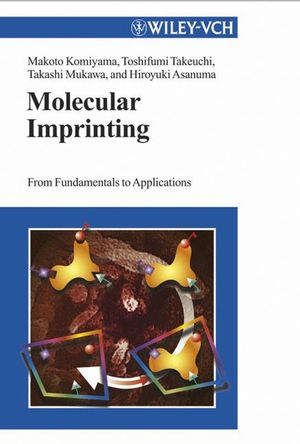Molecular Imprinting: From Fundamentals to ApplicationsISBN: 978-3-527-30569-8
Hardcover
159 pages
February 2003
 |
||||||
Preface
INTRODUCTION
Importance of Receptor Molecules in Advanced Science and Technology
Naturally Ocurring Receptors
Artificial Receptors
Receptors for Practical Applications
Why is the Molecular Imprinting Method so Promising?
FUNDAMENTALS OF MOLECULAR IMPRINTING
Introduction
General Principle of Molecular Imprinting
Covalent Imprinting and Non-covalent Imprinting
Advantages and Disadvantages of Covalent and Non-Covalent Imprinting
History
EXPERIMENTAL METHODS (I) -
PROCEDURES OF MOLECULAR IMPRINTING
Introduction
Reagents and Experimental Procedures
Covalent Imprinting
Non-covalent Imprinting
"Dummy Molecular Imprinting"
EXPERIMENTAL METHODS (II) -
EVALUATION OF IMPRINTING EFFICIENCY
Chromatographic Experiments
Batchwise Guest-Binding Experiments
Determination of Guest-Binding Constants
SPECTROSCOPIC ANATOMY OF MOLECULAR IMPRINTING REACTIONS
Introduction
Structures of Adducts in the Pre-organization Step
Determination of the Binding Constant K for the Formation of Monomer-Template Adduct
Relationship between K Value and Imprinting Efficiency
Structure of the Guest-Binding Site
FLOW-CHART OF A TYPICAL MOLECULAR IMPRINTING
Introduction
Choice of Agents
Polymerization
Packing of Imprinted Polymers into the HPLC Columns
Quantitative Evaluation of Imprinting Efficiency
APPLICATIONS OF MOLECULARLY IMPRINTED POLYMERS
Introduction
Sensor Applications
Signaling Polymers
Molecularly Imprinted Sorbent Assays
Molecularly Imprinted Membranes
Affinity-based Solid-phase Extraction
Molecularly Imprinted Catalysts
RECENT CHALLENGES AND PROGRESS
Introduction
Molecular Imprinting in Water
Use of Two Kinds of Functional Monomers for Cooperative Recognition
Inorganic Gel as the Matrix for Molecular Imprinting
Artificial Enzyme (Molecular Catalyst) by Molecular Imprinting
Catalytic Antibody Prepared by Using Transition-State Analog
CONCLUSIONS AND PROSPECTS
Index
INTRODUCTION
Importance of Receptor Molecules in Advanced Science and Technology
Naturally Ocurring Receptors
Artificial Receptors
Receptors for Practical Applications
Why is the Molecular Imprinting Method so Promising?
FUNDAMENTALS OF MOLECULAR IMPRINTING
Introduction
General Principle of Molecular Imprinting
Covalent Imprinting and Non-covalent Imprinting
Advantages and Disadvantages of Covalent and Non-Covalent Imprinting
History
EXPERIMENTAL METHODS (I) -
PROCEDURES OF MOLECULAR IMPRINTING
Introduction
Reagents and Experimental Procedures
Covalent Imprinting
Non-covalent Imprinting
"Dummy Molecular Imprinting"
EXPERIMENTAL METHODS (II) -
EVALUATION OF IMPRINTING EFFICIENCY
Chromatographic Experiments
Batchwise Guest-Binding Experiments
Determination of Guest-Binding Constants
SPECTROSCOPIC ANATOMY OF MOLECULAR IMPRINTING REACTIONS
Introduction
Structures of Adducts in the Pre-organization Step
Determination of the Binding Constant K for the Formation of Monomer-Template Adduct
Relationship between K Value and Imprinting Efficiency
Structure of the Guest-Binding Site
FLOW-CHART OF A TYPICAL MOLECULAR IMPRINTING
Introduction
Choice of Agents
Polymerization
Packing of Imprinted Polymers into the HPLC Columns
Quantitative Evaluation of Imprinting Efficiency
APPLICATIONS OF MOLECULARLY IMPRINTED POLYMERS
Introduction
Sensor Applications
Signaling Polymers
Molecularly Imprinted Sorbent Assays
Molecularly Imprinted Membranes
Affinity-based Solid-phase Extraction
Molecularly Imprinted Catalysts
RECENT CHALLENGES AND PROGRESS
Introduction
Molecular Imprinting in Water
Use of Two Kinds of Functional Monomers for Cooperative Recognition
Inorganic Gel as the Matrix for Molecular Imprinting
Artificial Enzyme (Molecular Catalyst) by Molecular Imprinting
Catalytic Antibody Prepared by Using Transition-State Analog
CONCLUSIONS AND PROSPECTS
Index



